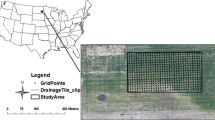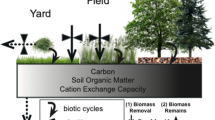Abstract
Understanding the magnitude and location of soil phosphorus (P) accumulation in watersheds is a critical step toward managing runoff of this pollutant to aquatic ecosystems. Here, I examine the usefulness of urban–rural gradients, an emerging experimental design in urban ecology, for predicting extractable soil P concentrations across a rapidly urbanizing agricultural watershed in southern Wisconsin. I compare several measures of an urban–rural gradient to predictors of soil P such as soil type, slope, topography, land use, land cover, and fertilizer and manure use. Most of the factors that were expected to drive differences in soil P concentrations were found to be poor predictors of Bray-1 (extractable) soil P, which ranged from 4 to 660 ppm; while there were several significant relationships, most explained only a small proportion of the variation. A multiple linear regression model captured approximately 37% of the variation in the data using the urban–rural gradient, topography, land use, land cover, manure use, and soil type as predictors. There was a significant relationship between Bray-1 P concentration and each of the urban–rural gradients, but these relationships explained only between 2.6% and 3.3% of the variation in P concentrations. Extractable P concentration in soils, unlike some other ecosystem properties, is not well predicted by urban–rural gradients.






Similar content being viewed by others
References
K. E. Arbuckle J. A. Downing (2001) ArticleTitleThe influence of watershed land use on lake N:P in a predominantly agricultural landscape. Limnology and Oceanography 46 970–975
J. W. Baxter S. T. A. Pickett J. Dighton M. M. Carreiro (2002) ArticleTitleNitrogen and phosphorus availability in oak forest stands exposed to contrasting anthropogenic impacts. Soil Biology and Biochemistry 34 623–633 Occurrence Handle10.1016/S0038-0717(01)00224-3 Occurrence Handle1:CAS:528:DC%2BD38XivVahs7s%3D
M. N. Beaulac K. H. Reckhow (1982) ArticleTitleAn examination of land use—nutrient export relationships. Water Resources Bulletin 18 1013–1024 Occurrence Handle1:CAS:528:DyaL3sXlvFCnsQ%3D%3D
E. M. Bennett S. R. Carpenter N. F. Caraco (2001) ArticleTitleHuman impact on erodable phosphorus and eutrophication: a global perspective. BioScience 51 227–234
Berry, B. J. L. 1991. Urbanization. Pages 103–119 in B. L. Turner, W. C. Clark, R. W. Kates, J. F. Richards, J. T. Mathews, and W. B. Meyer (eds.), The Earth as transformed by human action. Cambridge University Press with Clark University, Cambridge, UK.
R. B. Blair A. E. Launer (1997) ArticleTitleButterfly diversity and human land use: species assemblages along an urban gradient. Biological Conservation 80 113–125 Occurrence Handle10.1016/S0006-3207(96)00056-0
M. A. Bowers B. Breland (1996) ArticleTitleForaging of gray squirrels on an urban-rural gradient: use of the GUD to assess anthropogenic impact. Ecological Applications 6 1135–1142
G.E.P. Box W.G. Hunter J.S. Hunter (1978) Statistics for experimenters Wiley New York
Breitburg, D. L., J. W. Baxter, C. A. Hatfield, R. W. Howarth, C. G. Jones, Lovett, G. M., and C. Wigand. 1998. Understanding effects of multiple stressors: ideas and challenges. Pages 416–431 in M. L. Pace and P. M. Groffman (eds.), Successes, limitations, and frontiers in ecosystem science. Springer-Verlag, New York.
M. M. Carreiro K. Howe D. F. Parkhurst R. V. Pouyat (1999) ArticleTitleVariation in quality and decomposability of red oak lead litter along an urban-rural gradient. Biology and Fertility of Soils 30 258–268 Occurrence Handle10.1007/s003740050617
Dane County Regional Planning Commission. 1998. 1997 Regional trends: Dane County, Wisconsin. Dane County Regional Planning Commission, Madison, Wisconsin.
C. R. Frink (1991) ArticleTitleEstimating nutrient exports to estuaries. Journal of Environmental Quality 20 717–724 Occurrence Handle1:CAS:528:DyaK38XhtV2itw%3D%3D
N. B. Grimm M. Grove S. T. A. Pickett C. L. Redman (2000) ArticleTitleIntegrated approaches to long-term studies of urban ecological systems. BioScience 50 571–584
G. Heckrath P. C. Brookes P. R. Poulton K. W. T. Goulding (1995) ArticleTitlePhosphorus leaching from soils containing different phosphorus concentrations in the Broadbalk experiment. Journal of Environmental Quality 24 904–910 Occurrence Handle1:CAS:528:DyaK2MXot1Wks7k%3D
T. E. Jordan D. L. Correll D. E. Weller (1997) ArticleTitleEffects of agriculture on discharges of nutrients from coastal plain watersheds of Chesapeake Bay. Journal of Environmental Quality 26 836–848 Occurrence Handle1:CAS:528:DyaK2sXjsVCqtLs%3D
K. E. Limburg R. E. Schmidt (1990) ArticleTitlePatterns of fish spawning in Hudson River tributaries: response to an urban gradient? Ecology 71 1238–1245
M. Luck J. Wu (2002) ArticleTitleA gradient analysis of the landscape pattern of urbanization in the Phoenix metropolitan area of the USA. Landscape Ecology. 17 327–339 Occurrence Handle10.1023/A:1020512723753
R. E. McCollum (1991) ArticleTitleBuildup and decline in soil phosphorus: 30-year trends on a typic umprabuult. Agronomy Journal 83 77–85 Occurrence Handle1:CAS:528:DyaK3MXhvVChtbk%3D
McDonnell, M. J., and S. T. A. Pickett. 1991. Comparative Analysis of ecosystems along gradients of urbanization: opportunities and limitations. In G. L. J. Cole and S. Findlay (eds.), Comparative analyses of ecosystems: patterns, mechanisms, and theories. Springer-Verlag, New York.
M. J. McDonnell S. T. A. Pickett (1993) Humans as components of ecosystems Springer-Verlag New York
M. J. McDonnell S. T. A. Pickett P. Groffman P. Bohlen R. V. Pouyat W. C. Zipperer R. W. Parmelee M. M. Carreiro K. Medley (1997) ArticleTitleEcosystem processes along an urban-rural gradient. Urban Ecosystems 1 21–36 Occurrence Handle10.1023/A:1014359024275
K. E. Medley S. T. A. Pickett M. J. McDonnell (1995) ArticleTitleForest-landscape structure along an urban-to-rural gradient. Professional Geographer 47 159–168
Y. Natuhara C. Imai (1996) ArticleTitleSpatial structure of avifauna along urban-rural gradients. Ecological Research 11 1–9
S. T. A. Pickett (1997) ArticleTitleIntegrated urban ecosystem research. Urban Ecosystems 1 183–184 Occurrence Handle10.1023/A:1018579628818
R. V. Pouyat M. J. McDonnell (1991) ArticleTitleHeavy metal accumulation in forest soils along an urban–rural gradient in southeastern New York, USA. Water, Air and Soil Pollution 57–58 797–807
R. V. Pouyat R. W. Parmelee M. M. Carreiro (1994) ArticleTitleEnvironmental effects of forest soil-invertebrate and fungal densities in oak stands along an urban-rural land use gradient. Pedobiologia 38 385–399 Occurrence Handle1:CAS:528:DyaK2cXmvF2qt7Y%3D
R. V. Pouyat M. J. McDonnell S. T. A. Pickett (1997) ArticleTitleLitter decomposition and nitrogen mineralization in oak stands along an urban-rural land use gradient. Urban Ecosystems 1 117–131 Occurrence Handle10.1023/A:1018567326093
T. Reed-Andersen S. R. Carpenter R. C. Lathrop (2000) ArticleTitlePhosphorus flow in a watershed-lake ecosystem. Ecosystems 3 261–573 Occurrence Handle10.1007/s100210000049
SAS Institute (1989–1996) Propretary software release 6.12, SAS Institute, Cary, NC
InstitutionalAuthorNameSAS Institute (1995) Statistical analysis system user’s guide: statistics. Version 6.2 SAS Institute Cary, NC
A. Sharpley T. C. Daniel D. R. Edwards (1993) ArticleTitlePhosphorus movement in the landscape. Journal of Production Agriculture 6 507–513
A.N. Sharpley (1995) ArticleTitleDependence of runoff phosphorus on extractable soil phosphorus, Journal of Environmental Quality 24 920–926 Occurrence Handle1:CAS:528:DyaK2MXot1Wks7c%3D
A. Sharpley T. C. Daniel J. T. Sims D. H. Pote (1996) ArticleTitleDetermining environmentally sound soil phosphorus levels. Journal of Soil and Water Conservation 51 160–166
A. N. Sharpley H. Tunney (2000) ArticleTitlePhosphorus research strategies to meet agricultural and environmental challenges of the 21st century. Journal of Environmental Quality 29 176–181 Occurrence Handle1:CAS:528:DC%2BD3cXot1ejsg%3D%3D
R. R. Sokal F. J. Rohlf (1995) Biometry: the principles and practice of statistics in biological research. Freeman New York
H. Tunney (1990) ArticleTitleA note on a balance sheet approach to estimating the phosphorus fertiliser needs of agriculture. Irish Journal of Agricultural Research 29 149–154
H. Tunney O. T. Carton P. C. Brookes A. E. Johnston (1997) Phosphorus loss from soil to water. CAB International New York
USDA (United States Department of Agriculture). 1978. Soil survey of Dane County, Wisconsin. Soil Conservation Service in cooperation with the Research Division of the College of Agricultural and Life Sciences, University of Wisconsin.
R. H. Whittaker (1967) ArticleTitleGradient analysis of vegetation. Biological Reviews 49 207–264
Zhu, and Carreiro, M. 1999. Chemoautotrophic nitrification in acidic forest soils along an urban-to-rural transect. Soil Biology and Biochemistry 31:1091–1100.
Acknowledgements
I am very grateful to Tom Pearce and Colleen Flaherty, who helped with data collection and processing. Discussions with Steve Carpenter, Monica Turner, Emily Stanley, Kevin McSweeney, Pete Nowak, and Tim Essington and others helped clarify the thoughts behind this project. Pieter Johnson, Katie Predick, Margaret Carreiro, Jason Kaye, and Jim Baxter provided thoughtful and useful reviews of the manuscript in preparation. This research was funded by the National Science Foundation (NSF) through the Long Term Ecological Research (LTER) program and the Wisconsin IGERT (Integrative Graduate Education, Research, and Training) project.
Author information
Authors and Affiliations
Corresponding author
Rights and permissions
About this article
Cite this article
Bennett, E. Soil Phosphorus Concentrations in Dane County, Wisconsin, USA: An Evaluation of the Urban–Rural Gradient Paradigm . Environmental Management 32, 476–487 (2003). https://doi.org/10.1007/s00267-003-0035-0
Published:
Issue Date:
DOI: https://doi.org/10.1007/s00267-003-0035-0




